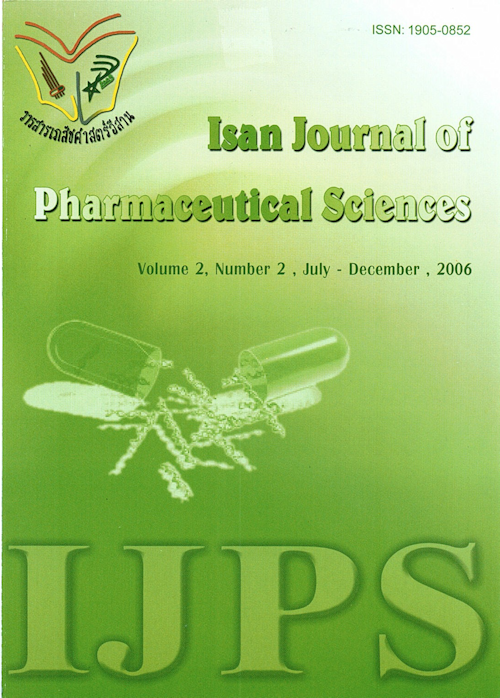Suitable Drying Conditions for Ginger Capsule Production
Main Article Content
Abstract
The objective of this work was to study the effects of drying temperature and moisture content on volatile oil content, flowability and microbial contamination of Ginger powder for capsule preparation. The quality of Ginger capsules was consequently investigated. The experiment was divided into 2 parts. The purpose of part I was to select the drying temperature that provided the highest amount of remaining volatile oil. Fresh ground Ginger was dried at 40, 50 and 60°c and the moisture content was less than 10 %v/w. The amount of volatile oil was consequently determined. The results showed that drying Ginger at 60° c gave the highest quantity of the remaining volatile oil (1.80 %v/w). The purpose of part II was to select the range of moisture content after drying which give the highest amount of volatile oil. Raw material was dried at 60° c until it reached 3 ranges of moisture content (3-5, 6-8 and 9-10 %v/w). The results indicated that dried Ginger powder with the moisture content of 6-7 %v/w contained the highest amount of volatile oil (1.75 %พ/'พ) and possessed fair flowability. Disintegration time and weight variation of Ginger capsules produced from this Ginger powder were within The Unites States Pharmocopoeia 27 limits. However, the capsules did not pass Thai Herbal Pharmacopoeia 2000 limits for microbial contamination.
It could be concluded that drying Ginger powder at the temperature of 60° c until the moisture content reached 6-7 %v/w may provide the highest volatile oil content and gave suitable powder properties for capsule filling. The capsules produced by this condition needs further process for microbial decontamination.
Article Details
In the case that some parts are used by others The author must Confirm that obtaining permission to use some of the original authors. And must attach evidence That the permission has been included
References
Department of Medical Sciences, Ministry of Public Health, Thailand. (2000). Appendix 7.3H Determination of volatile oil, Appendix 10.5 Limits for microbial contamination. In: Thai Herbal Pharmacopoeia Volume IL 2000. Bangkok: Prachachon.
Department of Medical Sciences, Ministry of Public Health, Thailand. (1993). Thai Pharmacopoeia Volume I Part 2. 1993. Bangkok : Prachachon. pp. 982.
The United States Pharmacopoeia Convention Inc. (2004). A2302, 2396 In: The United States Pharmacopoeia 27 (NF XXII). Rockville: The United States Pharmacopoeia Convention Inc.
World Health Organization. (1999). WHO monographs on selected medicinal plants. Volume I. Malta: WHO Graphics, pp. 280.


